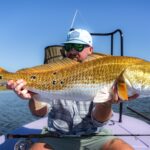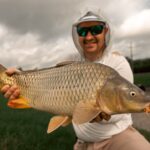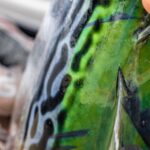
Louisiana Bull Reds Up for Harvest Again: H.B. 604 Must Not Pass
Photo Credit: Carter Abramson | Trevor Johnson Every now and then, we encounter something so
Striped Bass Are In Trouble
Originally Published Here on Fissues
By Tony Friedrich
Striped Bass anglers are concerned about the stock. From Maine to North Carolina, we have all witnessed a decline in the population. We’ve patiently waited for the next stock assessment scheduled for early 2019. We need the science, not just anecdotal information, to be able to influence the managers to lower mortality. Recently, the stock assessment workshop (SAW held a webinar, open to the public. The Stock Assessment Review Committee (SARC) reviewed the science from the benchmark stock assessment set to come out at the next ASFMC meeting.
There is a lot of explaining to do in order to understand what I’m about to show you. First and foremost, the SARC/SAW conclusions on the status of striped bass still have a very long process ahead. The final assessment and peer-review reports are still in draft. The main report will include the peer-review as well as potential changes from the Striped Bass Technical Committee. So, while the science is clearly there, we have a lot of obstacles to face before something meaningful can be done to save our beloved striped bass.
I’d like to revisit 2012 when harvest was reduced on the coast by 25% and in the Chesapeake Bay by 20.5%. Those reductions should have been in the neighborhood of 34%. But, the young of the year numbers for the 2011-year class came out and showed one of the best recruiting years on record.
The 2011-year class was supposed to save the stock. It was also a huge excuse not to take the cuts we needed. Furthermore, the bay states used the fact that female stripers start leaving the Chesapeake at age 3. So, it is a predominately male fishery. As the stock is managed on the population of spawning age females, males don’t really count in the grand scheme of things.
So, rather than do what was needed, the reduction was chipped away to 25% and 20.5% respectively. All the coastal states besides New Jersey met the goal. The bay states, in particular, Maryland did not. In 2012, Maryland anglers harvested 1.26 million pounds of striped bass. As the robust 2011-year class matured, the harvest skyrocketed to 4.3 million pounds in 2016. Here’s the link. It is on page 22 for those interested.
I’ll ask the folks from the coast one very simple question. Did you see a dramatic rise in the number of striped bass in the 28 to 32-inch range? If you didn’t, it is because Maryland anglers slaughtered the year class as soon as it became legal to do so. Apparently, not all the females leave at age 3.

Striped bass are managed on biological reference points (BRP’s). The dotted line is the threshold and the stock of spawning females cannot fall below this number. Please note that this chart is based on pounds of fish. You will need to remember that moving forward.
The threshold female spawning stock biomass was based on its abundance in 1995. That makes a lot of sense to me. 1995 was the year the stock was declared recovered. It should be a valuable memory to hold dear. 1995 represents a time when all of the sacrifice played out in the most important fishery in the Mid-Atlantic and Northeast coming back from the brink.
I do some work in the clean water arena. One of the greatest tricks ever played is to shift baseline. When an entity doesn’t meet water quality standards, the standards can always be lowered. That’s a lot easier than doing the hard work needed to meet the standard. Attempts have already been made to shift the baseline for striped bass.
About a year ago, I started hearing whispers in various meetings. People were saying that the current biological reference points (BRPs) were unattainable. Then, things got worse. Entire models were developed for alternate management approaches. As you can guess, these models would have allowed for greater harvest.
I want you all to consider the ramifications of these events. If the BRP’s are adjusted, that will be the new normal. If the threshold is lowered, 2018 is the new norm… shifting baselines at its best. The alternate models failed peer review at SARC/SAW. We dodged a bullet. It is striking to think that biologists would work so hard to make striped bass fishing worse, but that was the task that they were given by the Striped Bass Management Board. So the threat is still there. There will be a great effort to shift the female spawning stock biomass threshold to a lower level, and increase the threshold for fishing mortality.
We should all be familiar with the Marine Recreational Information Program (MRIP). It is the recreational data collection system that managers use to estimate our catch. MRIP is a relatively new system. It was reviewed by the National Academy of Sciences earlier in the year and found to be acceptable. There were several suggestions to improve the data. One of these suggestions was using cell phones rather than house phones for surveys. While that has not yet been done, MRIP has replaced the household telephone survey with a survey sent out in the mail. This simple change resulted in more robust data as well as the reality that stripers are being harvested at a greater rate than previously thought.

The amber line is the previous accepted harvest rate. The blue line is the new harvest rate based on the MRIP re-calibration. Please understand the MRIP is a data collection system for anglers, not commercial fishermen. Because the harvest is greater, that means that there must have been more fish in the system that previously assumed. It isn’t a one for one transaction. Statistics and models never are. But, let’s just say we weren’t just harvesting more, there were more fish out there than previously assumed. This data adjusted the BRP’s by proxy.
That’s about all the background information you need to understand what I’m about to show you. This is a screen shot of the conclusion from the SARC/SAW webinar.

Striped bass are overfished and overfishing is occurring according to these numbers. The re-calibrated threshold is 91,436 mt. The SSB population is at 68,476 mt. That’s less than 75% of the threshold number. The last time we have been this low was in 1993, two years before the moratorium was lifted. The (f) number is the variable used to represent fishing mortality. The max allowed is .240. We are killing them at a rate of .307.
Striped bass aren’t out in the ocean. We aren’t using the wrong bait. It isn’t the commercial sector’s fault. WE KILLED THEM. Let that sink in.
There is no 2011-year class waiting to replenish the stocks. They died at the hands of Maryland anglers. We now sit on the precipice of a managerial struggle.
There are many that will try to shift the baseline by using lowering the BRP’s. They will say that the holding capacity of the Chesapeake Bay isn’t the same as 2006 when the stock peaked. They will say that the current levels are unattainable. How can we attain the proper population level, while killing them at this rate? They will try every trick in the book.
It rests on our shoulders and ours alone to make sure the striped bass population recovers. It will take a herculean effort to turn the tide. But we can do it. Do we have any other choice?
Striped bass have given us all countless good memories. They have taught our children countless lessons about the ocean and how to care for it. They have helped forge friendships. They have created a mutual bond across the coast.
Don’t they deserve our time and effort when it is most needed? Haven’t stripers given enough? At what juncture do we decide to give back? The time is now.
Saddle up everyone, we have until February 2019 to create an uproar.
Be certain that the harvest more side will be working tirelessly to exploit the system. We have to work just as hard and hope that it is enough to ensure that those bonds, friendships, and lessons can continue with the next generation.

Photo Credit: Carter Abramson | Trevor Johnson Every now and then, we encounter something so

This past weekend, ASGA proudly sponsored the Dirty Carp Tournament in Louisiana — and no, you didn’t misread that.

After years of data pouring in from The Albie Project, advocacy, persistence, and support from

This morning, the Connecticut Environment Committee held a hearing on House Bill 6248, a bill
We rely on our members and donations to keep fighting for a sustainable tomorrow in marine conservation.
GIVE THE GIFT OF FISHERIES CONSERVATION THIS HOLIDAY SEASON. SHOP ASGA GOODS THAT FUND FISHERIES RESEARCH & ADVOCACY CAMPAIGNS
JOIN ASGA IN CALLING FOR CRITICAL MANAGEMENT ACTION AFTER YEARS OF SPAWN FAILURES & POOR MANAGEMENT.
By using this website, you agree to our use of cookies. We use cookies to provide you with a great experience and to help our website run effectively. To learn more, please review our privacy policy.